 Bernie Sanders’s surprise double-digit win was undeniably the big story of the night, but progressives can find even more good news from the turnout numbers. At 121,923, total Democratic turnout was a whopping 98.6 percent higher than the GOP’s 61,394. To put this in perspective, Obama only won 77.9 percent more votes than Romney.
Bernie Sanders’s surprise double-digit win was undeniably the big story of the night, but progressives can find even more good news from the turnout numbers. At 121,923, total Democratic turnout was a whopping 98.6 percent higher than the GOP’s 61,394. To put this in perspective, Obama only won 77.9 percent more votes than Romney.
To make these results even more stunning, the media’s insistence on over-covering Donald Trump should have juiced the GOP’s numbers, and the media narrative that the Democratic race is over should have depressed the Democratic numbers. But apparently not. The GOP also benefited from a three-way race, which should boost turnout over a two-way like the Democratic contest. Even with these advantages, Democrats solidly outperformed Republicans in turnout.
Unfortunately, some pundits have spun these results as good news for the GOP, pointing to the fact that GOP turnout was up over the 2008 primary. But that analysis conveniently forgets that John McCain had already sown up the Republican nomination by the time Rhode Island voted, while the Obama/Clinton race was very hotly contested.
In the real world, it is difficult to interpret these results as anything but more evidence that Rhode Island is moving to the left. On the right, some Republicans believe that voter anger at the right-wing Democratic establishment’s policies will deliver a red wave in November. Some pundits have begun parroting their talking points. Channel 10 political analyst Wendy Schiller even posited that Donald Trump might win Rhode Island. Fortunately, it looks like Rhode Islanders are too smart to vote for Trump. If these turnout numbers hold, the Republican Party will have a rough November in our state.
]]>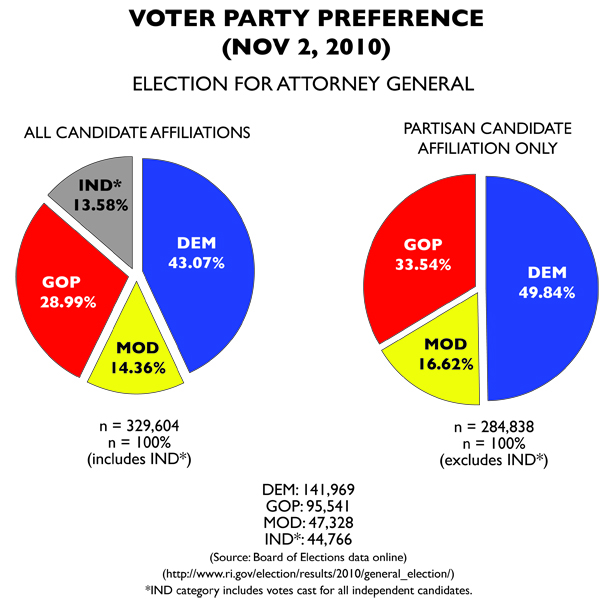
The problem with the gubernatorial results is the massive amount of independent votes that have to be thrown out. Luckily, the AG race offers a more typically Rhode Island affair, though a large amount of independent votes are tossed, but only about equal to what the Moderate Party candidate earned.
That Moderate candidate is the most interesting. The former chair of Common Cause RI and the former President of Save the Bay, lawyer Christopher Little best represented the “environment and ethics” part of the Moderate platform. And his vote performance was better than that of his gubernatorial counterpart Ken Block. Why Little has never been emphasized by the Moderates since is an oddity to me.
If the AG race is used as our party preference ballot, the result is the best case for the Moderates short of winning a majority (which would require a crisis of voter faith).
What happens is that the Democrats retain a majority in the House (by one seat only) and have a plurality in the Senate (short by one seat). In this case, the large number of Reps and Senators won by the Moderates can act a drivers of policy. In the Senate, Democrats either have to make a coalition agreement with one of the two parties, or they have to manage to get a leadership team put together with the approval of some members of the other parties or independent Edward O’Neill.
O’Neill’s vote actually becomes very important as well. As an independent, he can be the deciding vote in a showdown between a Moderate-Republican coalition and the Democratic caucus.
The House is a bit different. House Democrats have to be really cautious and not bring any legislation to vote that alienates their caucus and fails to win cross-party support. Otherwise, they could see their leadership team overthrown by a group of disaffected Democratic reps allied with the Moderates and Republicans. Alternatively, they could spurn the left-wing of their party and join with Moderate or Republican legislators to form a cross-party leadership. However, that could damage all parties together, making Republican legislators vulnerable to right wing dissatisfaction, Democratic legislators vulnerable to left wing dissatisfaction, and Moderates vulnerable to voter scorn. How it would shake out would be largely due to personalities.
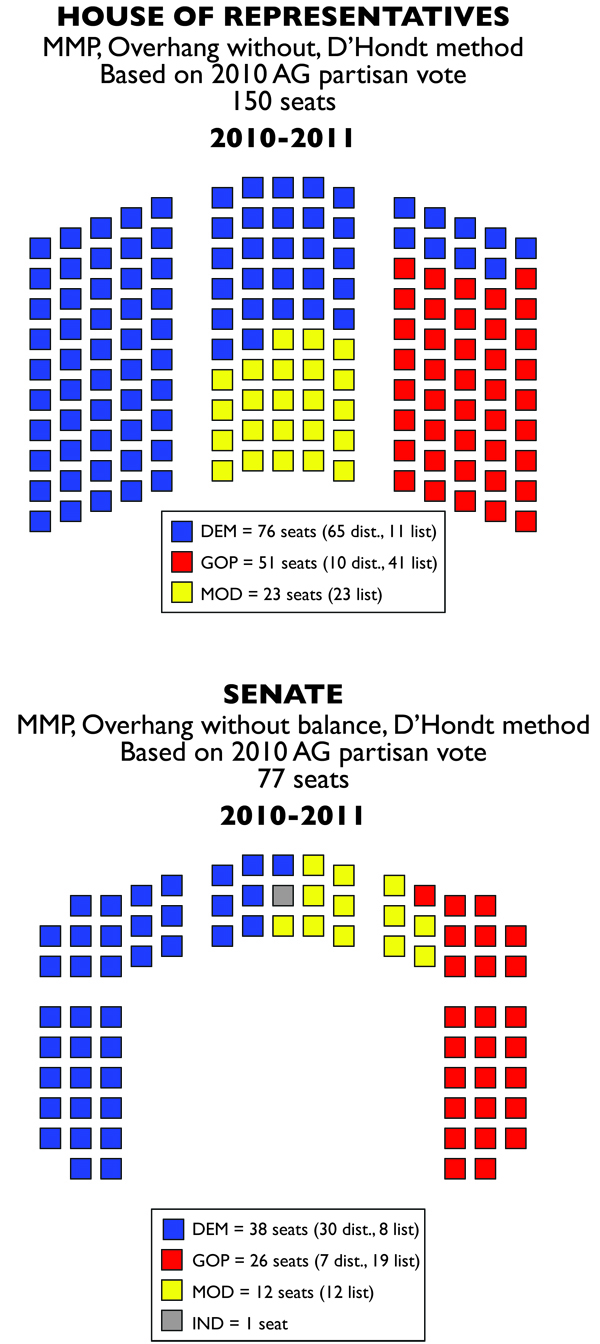
This is Part 12 of the MMP RI series, which posits what Rhode Island’s political landscape would look like if we had switched to a mixed-member proportional representation (MMP) system in 2002. Part 11 (a revisiting of the 2010 election based on gubernatorial results) is available here. Part 13 discusses other electoral reforms.
]]>The reason I’m focusing on these races is because they might give us an idea about what an MMP election might look like in Rhode Island with a party list vote. If you’ll remember, when MMP elections don’t rely on district results, there’s a separate ballot question asking what party a voter prefers. It’s like a statewide election for party, with the effect that it’ll change the party proportions in the chambers.
Let’s look at the gubernatorial election.
2010 MMP Election Using Gubernatorial Results
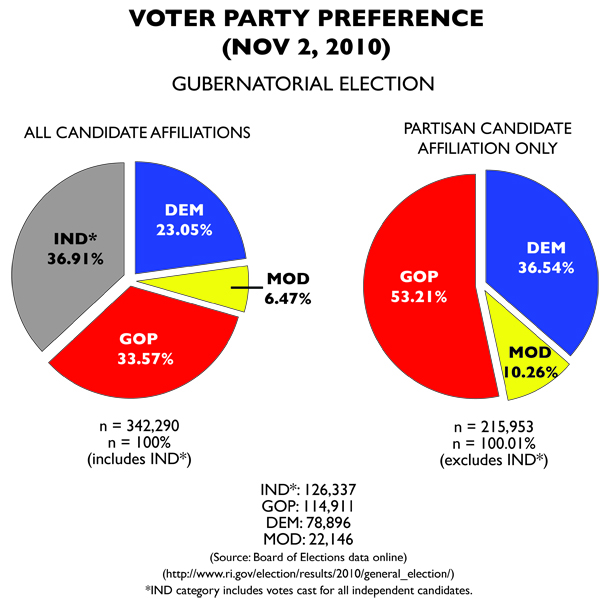
I like to think of this as the worst-case scenario for Democrats. First, I’ve removed all the independent voters, simply because it’s hard to simply declare they’d go to the Democratic Party. This means we’re looking solely at the votes that the Democrats, Republicans, and Moderates received. And there weren’t that many for Democrats.
Once again, the districts favor the Democrats. They win handily there, 65 seats in the House and 30 seats in the Senate. However, they have a terribly weak performance in the party list vote. In our alternate history version, we might speculate that in 2010 the depressed turnout of Democratic voters combined with Republican enthusiasm to increase the percentage of Republican votes.
The results in the districts allow Democrats to retain power disproportionate to what the D’Hondt method gives them. The D’Hondt method awards 55 seats to the Democrats in the House, but they win 65 in the districts. That means no one from their list makes it into the House. Republicans have a different result, with 7 out of 8 of their representatives from the list.
Both chambers result in overhang thanks to institutional Democratic advantage and the presence of Sen. O’Neill. What this leaves us with is a House with a Republican plurality (exactly 50%) and a Senate with a slight Republican majority. It’s impossible for either of the two biggest parties to form a veto-proof majority without being joined by many members of other parties. In the House, at least, there needs to be a coalition leadership team. It’s either a Republican-Moderate coalition which fails to give a veto-proof supermajority, or it’s a Grand Coalition between Democrats and Republicans. So it’s probably going to be the former, but the longer MMP lasts, the more likely the latter might get (difficult as it is to imagine now).
In many ways, this is not a good position for the Moderates (despite the fact they’re in the General Assembly). Being a junior member of a coalition is a troubling position to be in, especially when much of the Moderate brand is attempting to say that they’re not Republicans (witness the Liberal Democrats in the UK). On the other hand, should they refuse to sign a coalition agreement in the House, it’ll be easy to portray them as being responsible for that chamber’s instability.
And instability ultimately seems likely to happen. With slim majority control in one chamber and a coalition in the other, Republicans would be forced to find the broad consensus in their decision-making very quickly. It’s a lot easier to whip 10 representatives than to whip 80, and Republicans have never had to whip a majority of a chamber to pass legislation since they last were in power. They’d have to learn fast.
Part of what makes the Democratic Party so effective in its control of the General Assembly is that it usually knows how to shunt aside irrepressible dissenters and how to bring along just enough people to have a large majority. This is what made the failure of the pension amendment to the budget such a surprise. The Democratic leadership doesn’t get blindsided, they blindside others.
Those effective masters of parliamentary maneuver don’t disappear either. They’d be out there causing trouble for Republicans. And with so many new legislators in their caucuses, Republicans would have a hard time keeping any dissenters from breaking ranks.
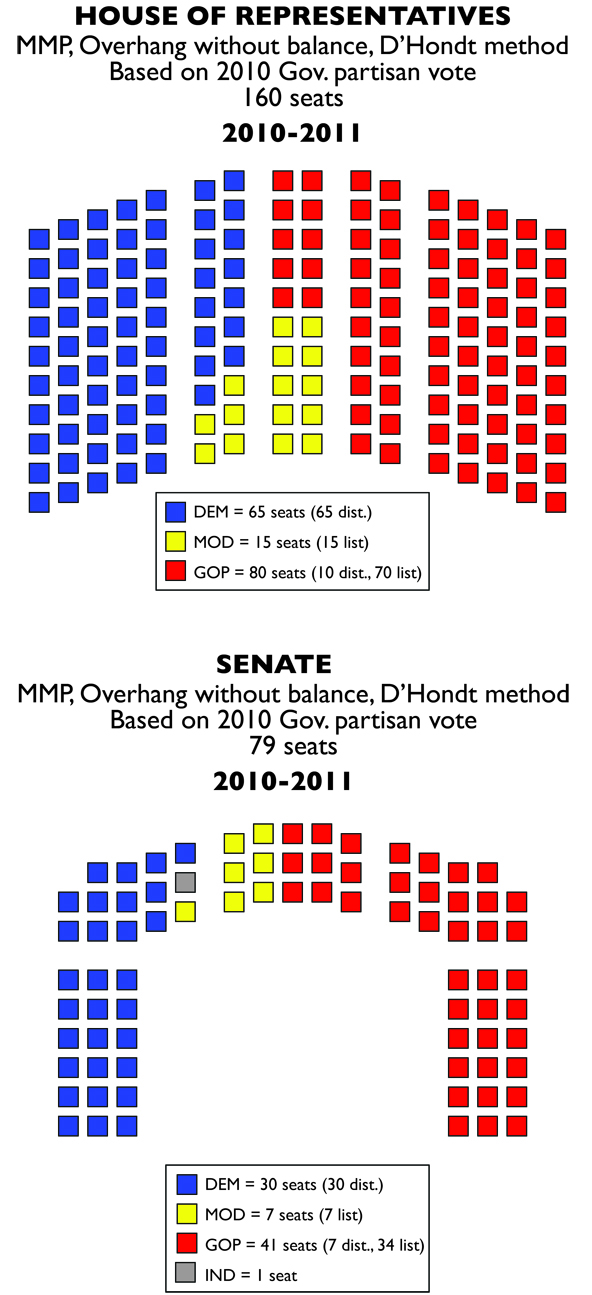
This is Part 11 of the MMP RI series, which posits what Rhode Island’s political landscape would look like if we had switched to a mixed-member proportional representation (MMP) system in 2002. Part 10 (a discussion of limitations) is available here. Part 12 is another look at the Election of 2010 using the Attorney General results.
]]>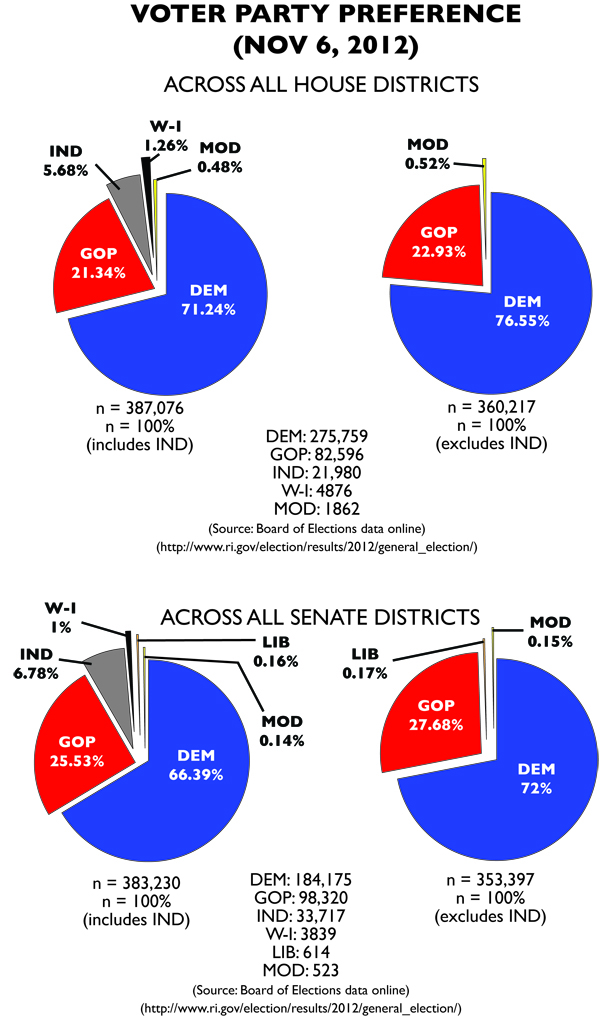
Nationally, Barack Obama was campaigning for a second term. Democrats were convinced they would win, while Republicans were convinced they would win. While Rhode Island was a sure thing, the chance to vote for President increased turnout to historic proportions.
This was bad news for the Republicans and Moderates in the General Assembly. Democratic voters completely overwhelmed their candidates, and many General Assembly candidates never faced opposition in the general election. State Republican Party chairman Mark Zaccaria’s “quality over quantity” strategy was especially foolish in this environment. Republicans actually lost votes from 2010, as many voters were denied the ability to select a Republican for General Assembly at the polls.
The Moderates were unable to hang on to their two seats. Though they finally contested the Senate, they pulled fewer votes than in 2010, and the Democratic tide significantly increased the hurdle to receive seats under the apportionment method. They were less successful than the Green Party had been in 2004, and the Greens lacked the institutional advantage of being a recognized party.
Democrats also avoided a repeat of the Montalbano episode in the House, as Speaker Gordon Fox held off independent challenger Mark Binder. Fox would now preside over a delegation of 109 Democrats, while his Senate counterpart President M. Teresa Paiva Weed would have 55 Democrats. Once again, the Democratic Party had its veto-proof supermajority.
Implications
2012 burst the Republican balloon, especially after conservative media predicted a blowout for Mitt Romney. National Republican obstinacy seems like it may have convinced a large number of Democrats that it’s not a safe thing to stay home. The other thing is that 2012 brought Democratic voters out at levels about what one would expect in a presidential election year. But Republican voters appear at rates just slightly better than 2006; their worst election.
Part of this really is attributable to the lack of competition. As I’ve said before, challenger apathy effects both sides roughly equally, with an advantage going to Senate Democrats. Zaccaria’s strategy of not spending resources on races Republicans can’t win sort of ignores the fact that there’s really little data about what races Republicans can win that they don’t already have a solid lock on. Senate Minority Leader Dennis Algiere regularly racks up around 11,000 votes in his usually uncontested general elections, making him one of the Senate’s highest vote-getters. House swing districts like 71 and 72 (held by right-wingers Dan Gordon and Dan Reilly, respectively) returned lefty Democrats in 2012; in the case of 71, Republicans failed to even put up a challenger.
In an MMP election where the district results are tied to your party’s seat total, failing to run candidates can have a very disastrous effect. A few hundred write-in votes are nothing compared to the huge amount of votes incumbents get. In a purely FPTP system like we have now, it also deprives Republicans of the ability to point out how popular their ideas are statewide. Part of this is because their ideas really aren’t so popular. In this case, it’s actually better for Republican self-image to automatically lose a third of all races and then complain about voters voting for Democrats. In far too many races, voters didn’t have a choice.

This is Part 9 of the MMP RI series, which posits what Rhode Island’s political landscape would look like if we had switched to a mixed-member proportional representation (MMP) system in 2002. Part 8 (the Election of 2010) is available here. Part 10 is a look at the limitations of this series.
]]>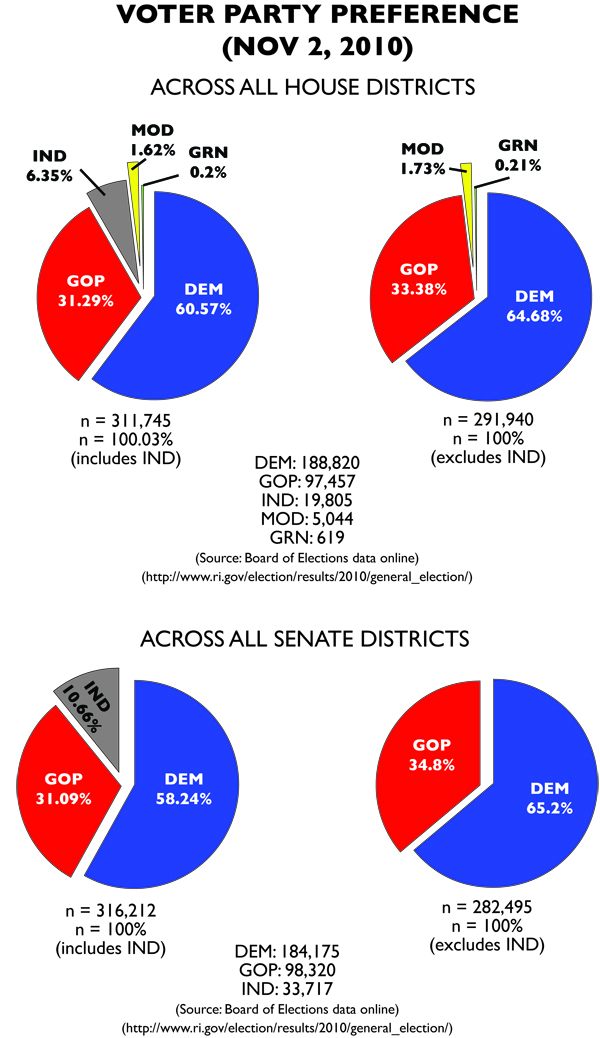
President Obama’s first term had devolved into the massive bungling of the Affordable Care Act. Republican intransigence in Washington combined with Obama’s refusal to stake out positions for his healthcare reform left Democratic partisans confused and disheartened. Meanwhile, Republicans were rallying against any change, and they had fired themselves up into a new movement, the Tea Party.
In Rhode Island, the situation was more confused. While the Republicans had nominated outgoing Gov. Carcieri’s senior communications advisor, the Democrats had selected General Treasurer Frank Caprio. Meanwhile, Ken Block was running at the top of the ticket for Rhode Island’s newly minted third party, the Moderates. But the candidate who had the most name recognition was former US Sen. Lincoln Chafee.
Since his defeat in 2006, Chafee had unaffiliated and back Barack Obama’s election in 2008. He would go on to narrowly win the Governorship, after Caprio insulted the President and it made national news. Staunch Democratic voters were left with little choice but to choose Chafee, the man they had rallied to defeat merely four years before.
The key issue that would effect apportionment of the General Assembly were the Moderate candidates for the House. While they captured only 1.62% of the vote for House candidates, this meant they had enough to gain two seats in that chamber from their list. For first time possibly since the 1850s, a party other than the Democrats or Republicans had access to the most powerful part of Rhode Island government. Democrats also lost their veto-proof supermajority in both chambers.
Those gains came at the expense of Democrats, who lost 10 seats, with two going to the moderates, and eight going to the Republicans. Republicans managed to gain three seats from the districts as well.
In the Senate, Democrats lost six seats to the Republicans, four of which were from districts. Observers attributed the success to an abundance of general election races in the districts, though noted that much of those contests were due to independent candidates.
Implications
The 2010 election is the most interesting to me (after 1996’s Year of the Cool Moose), and it’s one I’ll return to later, but mainly because it features two statewide races with a third party candidate in it. The other thing is the nature of the Republican gains.
Even in real life, Republicans managed to increase their seats by 100% in the Senate and 50% in the House. The gains are less stunning in MMP, but still significant. And the primary reason wasn’t GOP motivation. Take the 2004 and 2006 elections for Democrats. Democrats won in 2006 (in the MMP version of events) due to a combination of Democratic fervor and Republican apathy.
For Republicans in 2010, their gains were almost completely due to Democratic apathy. While collectively, Republicans shed around 3000-10,000 votes, Democrats collectively lost over 90,000. These missing Democratic voters are what give the Republican Party gains, and why in the MMP version, the Moderates are able to enter the House. The Tea Party is really overblown in RI, because 2010 isn’t an election where the right wing rises up, it’s one where the left wing stays home.
The other thing to consider is that 2010 is the election in which the fewest candidates are without a challenger in the general election. It’s stating the obvious, but it’s impossible to beat an incumbent when no one runs against them.
2010 also lends credence to the idea that the way towards a healthy opposition to the Democratic Party in Rhode Island is not from the right as the Republicans and Moderates are trying, but rather from the left. A coordinated statewide campaign that effectively played on the disappointment many Democratic voters have had with the spinelessness of Democratic politicians could reap unexpectedly large dividends.
Alternatively, if Republicans wanted to win, they actually might benefit from a campaign that preyed on this disappointment to drive down Democratic turnout.
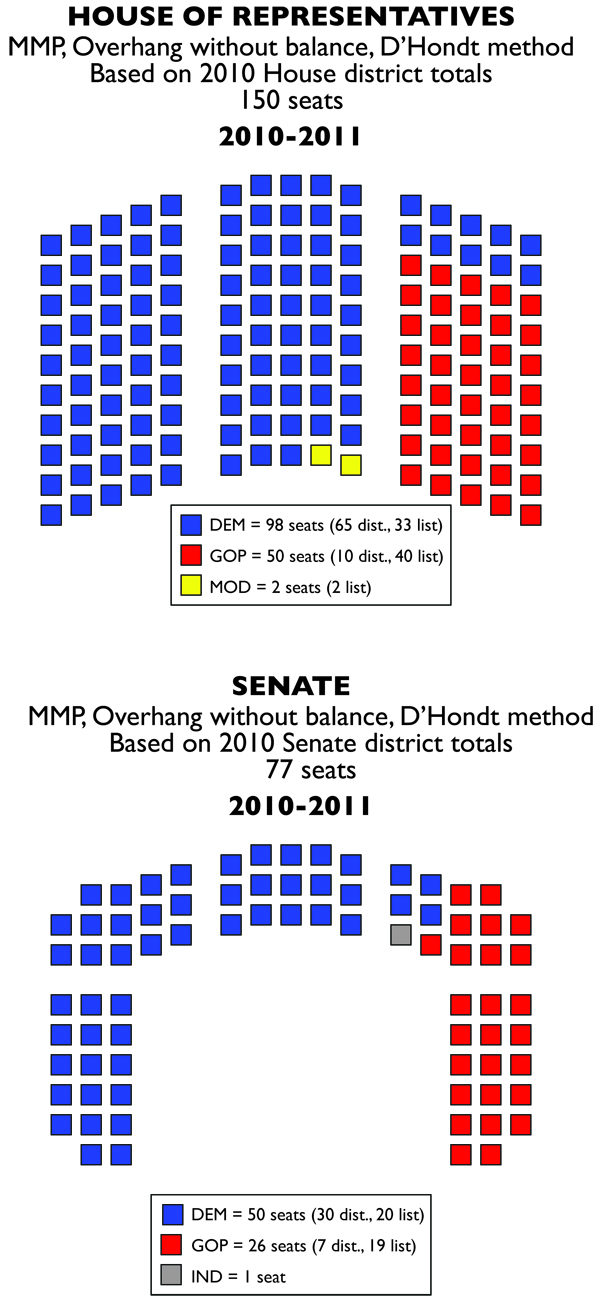
This is Part 8 of the MMP RI series, which posits what Rhode Island’s political landscape would look like if we had switched to a mixed-member proportional representation (MMP) system in 2002. Part 7 (the Election of 2008) is available here. Part 9 is a look at the Election of 2012.
]]>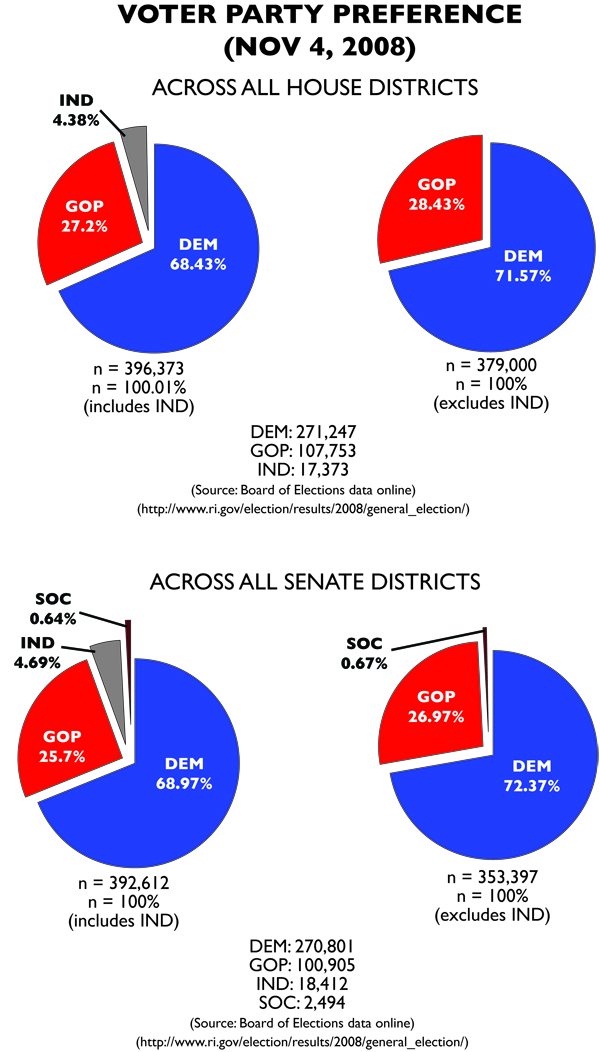
The 2008 election promised more bad news for the Republicans. Their nominee for President, US Sen. John McCain of Arizona, wasn’t particularly well-liked by his party’s base. While attempting to shed his “maverick” image (while at the same time attempting to play it up), McCain stumbled badly by adding half-term Gov. Sarah Palin to the ticket. Palin quickly became more popular than McCain, while at the same time becoming an anathema to moderates and liberals; ostensibly McCain’s strength lay in the idea he could appeal across the political spectrum.
In the face of this, Sen. Barack Obama was a stark contrast. His election would make a historic first of America’s first non-white president. Furthermore, he was intelligent, and a stirring orator. Obama was also the beneficiary of a large number of young voters, while he’d proven in his nomination fight he could defeat establishment political figures like Hillary Clinton. On top of NGP VAN, Obama was also establishing a new set of tools to improve campaigning, building a technological infrastructure that would serve to advantage the Democrats.
Finally, on top of all this, in September of 2008, the United States and the world suffered the worst economic catastrophe since the Great Depression. Americans have turned to the Democratic Party in times of economic peril since the Great Depression, and this year was to be no different.
However, Rhode Island’s General Assembly results were not as triumphant for the Democrats as one would expect in a presidential year favoring Democrats. Democrats actually lost 4 seats in the Senate and merely gained one in the House. Among the seats lost in the Senate was Senate President Montalbano’s, which was won by a political independent, Edward O’Neill.
O’Neill’s victory forced the General Assembly to exercise its overhang rules, meaning that one Democrat would become an extra seat. The Senate would now have 77 seats.
Though the results left the Democrats with a supermajority, Republicans were keen to portray it as a victory. In the face of stunning pressure, they’d managed gains.
Implications
2008 worked as a year of gains for the Democrats, who managed to continue an increase in turnout. While it didn’t match the upswing in votes for Republican candidates, it was enough to allow the Democrats to make a gain of seven seats in the House and take a Senate seat from Republicans while losing Montalbano’s. The MMP election shows why that seems out of sync with how we’d expect the results to shake out.
Something noteworthy in the 2008 election is that Republican Senator Francis Maher faced a Socialist Party candidate. That Socialist won nearly 2500 votes in a district that Democrats normally failed to even mount a challenger in.

This is Part 7 of the MMP RI series, which posits what Rhode Island’s political landscape would look like if we had switched to a mixed-member proportional representation (MMP) system in 2002. Part 6 (the Election of 2006) is available here. Part 8 is a look at the Election of 2010.
]]>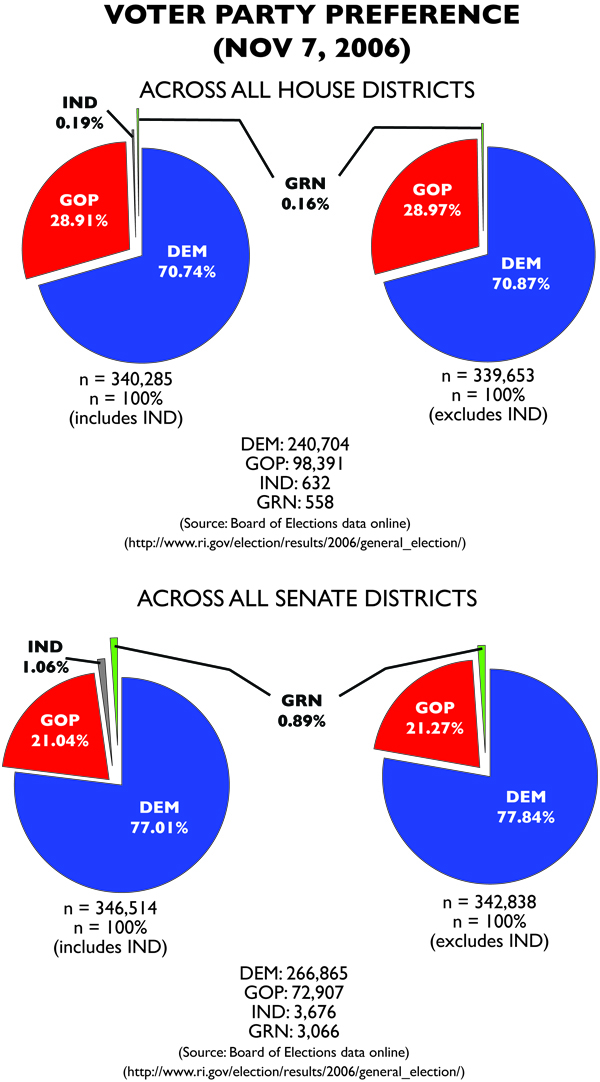
Nationally, the Bush Administration’s bungling of immigration reform and the ongoing failure to end the Iraq War (while the falsification of the cause for war was becoming apparent) had made the Republican Party toxic. At the same time, Howard Dean’s chairmanship of the Democratic Party began institutionalizing data collection for the party via NGP VAN. Democrats were vitalized to throw the Republicans out of power, ending GOP dominance in Washington since the Contract With America.
In Rhode Island, Republicans further weakened incumbent US Senator Lincoln Chafee by primarying him with right-winger Stephen Laffey. When combined with the anti-Republican fervor sweeping the country, he went down against former RI Attorney General Sheldon Whitehouse.
Gov. Donald Carcieri narrowly won reelection over Lt. Gov. Charlie Fogarty, and as usual, the whole slew of general officers below the gubernatorial level were returned as Democrats.
Low Republican turnout meant gains for Democrats in the GA. Close to 50,000 fewer people voted Republican in Senate races than in 2004, while around 30,000 fewer people voted Republican in House races. Combined with a failure to contest district seats, and Democrats saw significant gains. Democrats gained 10 seats in the House and nine seats in the Senate; with Republicans losing the equivalent.
Republicans complained about the master lever costing them votes. Democrats smiled.
Implications
In real life, this was not actually as stunning a shift. In an MMP election, the shifts are 10 seats in the House, 9 in the Senate; all to the Democrats. In reality, Democrats held steady at 33 seats in the Senate, and only gained two seats in the House. What’s even more stunning to me is that while votes for Republican candidates completely collapsed, Democrats actually boosted their turnout over 2004, which defies the common wisdom of “presidential election years favor Democrats because of high turnout.”
Interestingly enough, the vote for independent candidates completely cratered at this point, with House independents only receiving a combined 0.19% of the vote. In 2008, it would soar to the heights it’s achieved in the last three elections.
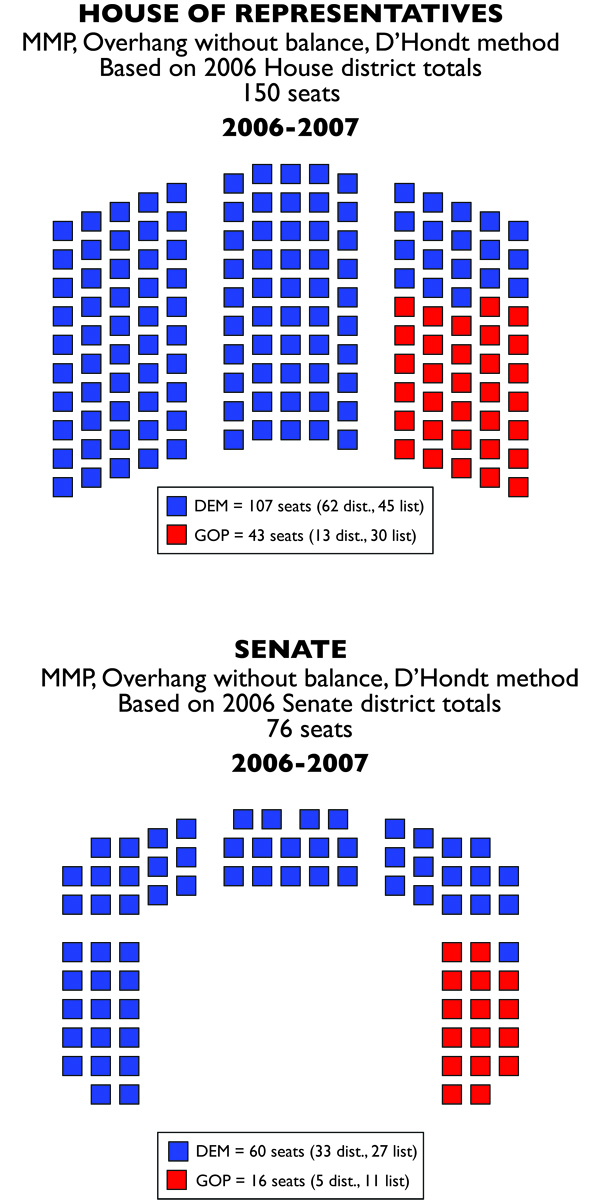
This is Part 6 of the MMP RI series, which posits what Rhode Island’s political landscape would look like if we had switched to a mixed-member proportional representation (MMP) system in 2002. Part 5 (the Election of 2004) is available here. Part 7 is a look at the Election of 2008.
]]>
Turnout was expected to be high in a presidential election year. The Iraq War, which had seen a nation toppled in less than a month, was entering a bloody phase. In April, the US Marines had been defeated at Fallujah, almost exactly a year after President Bush had declared “Mission Accomplished” aboard the USS Abraham Lincoln. Sen. John Kerry of Massachusetts attempted to hold Bush to one term, in a divisive election that helped solidify the idea of a “red state-blue state” divide in America.
Though Rhode Island was decisively a blue state, a dispute between Providence’s firefighters and Mayor Cicilline prevented Vice Presidential candidate John Edwards from visiting Rhode Island, as he refused to cross the union picket line.
In the General Assembly, Democrats lost seats, even as they won a new seat in Senate. Republicans seized upon that seat gain to suggest that redistricting was a problem; how had Democrats managed to gain a new district seat if their share of the votes had gone down? Democrats countered with the fact that a renewed emphasis on contesting seats had yielded the Republican four new district seats, defeating four Democrats in head-to-head races. Perhaps if Republicans focused on running instead of complaining, they might do better.
In total, Republicans gained two seats in the Senate and five seats in the House. Republicans told their members they were doing better, and the end of Democratic control was coming soon. Democrats grumbled.
Implications
In reality, though the Republicans gained four seats in the House, they actually lost a seat in the Senate. 2004 was the high watermark for Republican turnout, not as a percent wise, but total votes. In both House and Senate races, over 120,000 people cast their votes for Republican candidates. Collectively, Republican candidates tend to must 30,000 to 20,000 votes less. Though Republicans managed to turnout in large numbers, Democrats turnout in even higher numbers, improving somewhere around 40,000 voters over 2002.
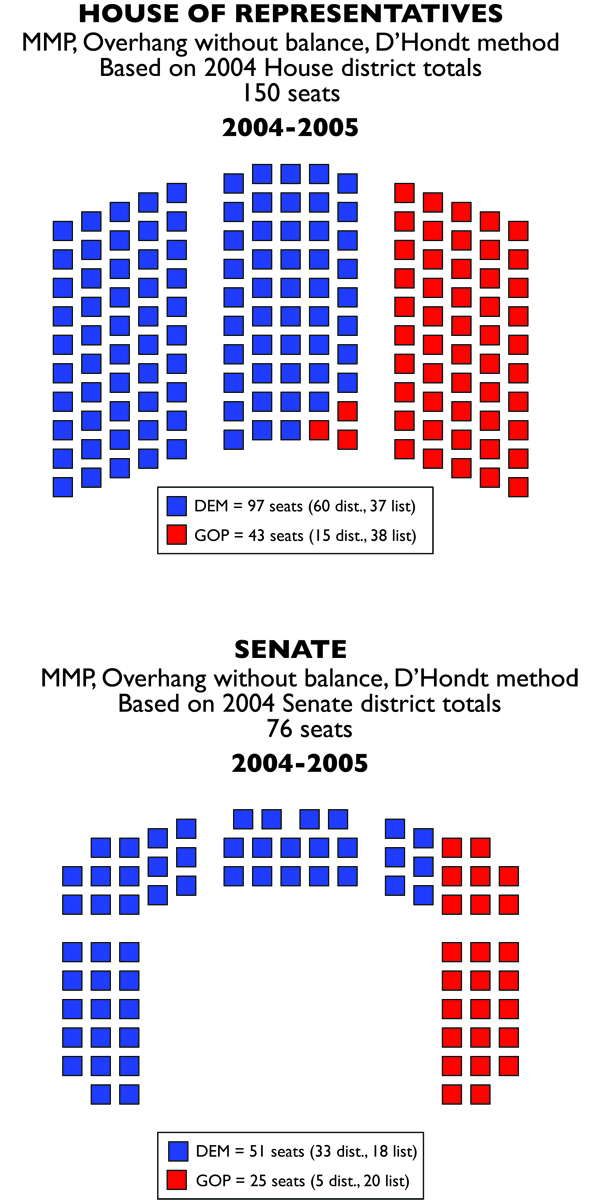
This is Part 5 of the MMP RI series, which posits what Rhode Island’s political landscape would look like if we had switched to a mixed-member proportional representation (MMP) system in 2002. Part 4 (the Election of 2002) is available here. Part 6 is a look at the Election of 2006.
]]>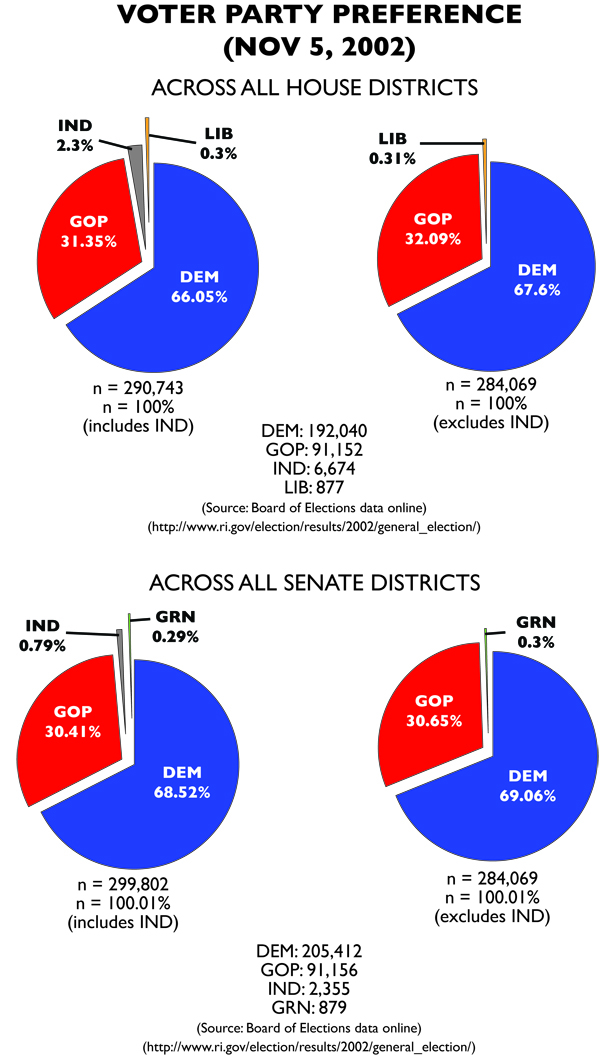
2002 was a momentous year for Rhode Island politics. State Representative David Cicilline announced he would challenge Buddy Cianci for Mayor of Providence. The capital city was also seeing a coalition of left-wing voters working to elect a young Green Party candidate David Segal to the city council. The major battle was between liberal standard-bearer former state Sen. Myrth York and conservative businessman Donald Carcieri.
In this atmosphere of change, so too was the General Assembly changing. Though its number of districts had been downsized, nearly a decade prior voters had approved an expansion of the Assembly; both chambers would practically grow by half.
The results of the election were stunning. Carcieri triumphed over York, who underperformed among Democrats. Cianci was eliminated before election day after being found guilty of racketeering conspiracy; after overcoming a primary election, Cicilline cruised to victory. Segal entered the Providence City Council as the minority leader, the sole member whose party wasn’t “Democrat”.
And in the General Assembly, the change was hard to interpret. Certainly, neither party “lost” seats. And yet, proportionally, the Republicans were stronger than they would have been in the old FPTP system. Instead of controlling a mere 14.67% of the seats in the House, they controlled 32% of the seats. In the Senate, the old way would’ve seen them earn 15.79% of the seats. The new method assigned them 30.26% of the seats.
However, the vast majority of Republican seats were from the party list, not from districts. Failure to contest as many seats meant that their candidates were more beholden to party, rather than to constituency. The Democrats had the opposite issue; their victory in the districts meant that they assigned fewer from the lists. The Democratic delegation would be mostly made up of incumbents, while the new Republicans would be mostly fresh-faced.
The Republicans claimed victory. Here was proof that Rhode Island’s corrupt system had prevented the full choice of the voters from being acknowledged. Democrats, for their part, grumbled, and went home with a slim supermajority of the General Assembly seats.
Implications
In reality, Democrats controlled roughly 85 percent of each chamber. Republicans were essentially shunted aside, even while winning slightly less than a third of the vote. So they controlled half of what they should have in the Assembly proportional to the votes they received.
In retrospect, it seems odd that the impetus for the General Assembly being shrunk was to create greater competition for seats. Mainly, because it failed to work; about a quarter of Senate seats were uncontested (10) as were a third of House seats (34).

This is Part 4 of the MMP RI series, which posits what Rhode Island’s political landscape would look like if we had switched to a mixed-member proportional representation (MMP) system in 2002. Part 3 (an explanation of MMP and an account of the methods used to create these posts) is available here. Part 5 is a look at the Election of 2004.
]]> In case you haven’t heard, the election for Rhode Island Republican chair has turned into a mess. And let’s remember, this wasn’t a paid position or even a position of much influence or power. After invalidating the 94-93 vote by the party’s central committee to make Warren Republican Town Committee chair Mark Smiley chair of the Rhode Island Republican Party, the missing voter has been found, and it was all a clerical error; this led Smiley’s opponent Dr. Dan Harrop (who last challenged David Cicilline for mayor of Providence) to challenge the result.
In case you haven’t heard, the election for Rhode Island Republican chair has turned into a mess. And let’s remember, this wasn’t a paid position or even a position of much influence or power. After invalidating the 94-93 vote by the party’s central committee to make Warren Republican Town Committee chair Mark Smiley chair of the Rhode Island Republican Party, the missing voter has been found, and it was all a clerical error; this led Smiley’s opponent Dr. Dan Harrop (who last challenged David Cicilline for mayor of Providence) to challenge the result.
But then, of course, it got worse. After an anonymous email from a hitherto unknown (and probably non-existent) Republican faction blasted the Smiley loyalists as bigots, former state senator Beth Moura left a semi-cryptic anti-GOP message on Harrop’s Facebook timeline. And finally, over at WPRO, Kim Kalunian has all the reactions from various Republican Party factions as of the end of Tuesday, including my personal favorite line refuting accusations of bigotry:
“We have friends and members that are Hispanic or black,” [Raymond] McKay [president of the Rhode Island Republican Assembly] said.
It would be funny if it weren’t so sad. Not a promising start to a position which is vaguely the de facto leader of the Rhode Island Republicans (at least in years without a Republican governor). Not a promising way for a chair who might need to “restore credibility” to the Republican Party in Rhode Island to win the position.
I don’t think the 94-93 split is as divisive as it seems. For one thing, the candidates don’t seem to be that distinguishable on issues (as even outgoing chair Mark Zaccaria said). Smiley supposedly is the conservative wing and Harrop is supposed the moderate wing. Another thing is that political parties’ central committees are rarely representative of the actual voters that make up a party; those feelings are more accurately gauged by the party primary for party purposes. 187 people probably do not represent all of Rhode Island’s roughly 80,000 registered Republicans. Central committees tend to be made up of the most active of the activists, not of the rank and file voters.
So while Republicans can probably put away any fear of a public defection of their moderate wing (it has been quietly defecting for years), this vote doesn’t bode well for their prospects. After all, if not a single General Assembly incumbent lost a seat in 2012 (the year 38 Studios collapsed), it seems unlikely that the GOP could make significant gains in the 2014 cycle (certainly not large enough to weaken Democratic control of the state). What this will do is create bad blood between party factions, and in a small state like Rhode Island, you need your party to at least be able to work together in a general election to share data, assist with voter registration and outreach, and cooperate during get-out-the-vote. If there’s too much tension, the lackluster effort the GOP already puts into those fields could be easily diminished.
Indeed, it seems likely that between General Treasurer Gina Raimondo and Providence Mayor Angel Taveras that the Democratic Party has two highly-popular and well-known figures to run for the state’s top office. The GOP’s top contenders seem to remain Cranston Mayor Allan Fung and Warwick Mayor Scott Avedisian. If the Democrats can seize the governor’s office, they might easily be able to hold it for the foreseeable future until the Republicans or another party finally emerge as a credible alternative.
]]>